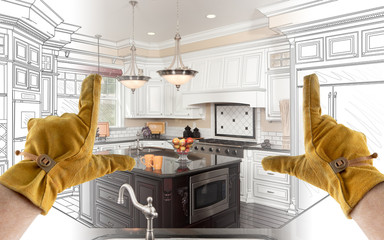Remodeling Contractor Mesa plays a vital role in helping property owners enhance, modernize, and customize their spaces. Whether it’s updating a single room or transforming an entire structure, these professionals combine design expertise, construction knowledge, and project management skills to deliver high-quality renovation results. Remodeling has become an essential service for both homeowners and businesses looking to improve functionality, aesthetics, and value. With the growing focus on comfort, sustainability, and modern design, remodeling contractors provide solutions that align with today’s lifestyle and building standards.
Home and commercial remodeling is more than just altering the physical layout—it’s about creating spaces that reflect the unique needs and vision of their occupants. A remodeling contractor takes on the responsibility of turning those ideas into reality, handling everything from initial planning to project completion. They work closely with clients to understand goals, budgets, and design preferences, then coordinate with designers, architects, and skilled tradespeople to ensure the project is executed seamlessly. This comprehensive approach ensures that every remodeling project, regardless of scale, is completed efficiently and to the highest quality standards.

One of the biggest advantages of working with a remodeling contractor is the expertise they bring to the table. These professionals are well-versed in the complexities of renovation work, including structural modifications, electrical and plumbing upgrades, material selection, and compliance with building codes. Their experience allows them to anticipate potential challenges and develop solutions that keep the project on track. In addition, contractors have access to trusted suppliers and skilled subcontractors, ensuring that each aspect of the remodel is handled by experienced professionals.
Home remodeling is one of the most common services provided by remodeling contractors. Property owners often seek to update older homes, improve functionality, or enhance aesthetic appeal. Popular home remodeling projects include kitchen and bathroom renovations, basement finishing, room additions, and whole-house makeovers. Each of these projects requires careful planning and execution to ensure that the improvements align with the homeowner’s lifestyle and the property’s architectural integrity. Remodeling contractors oversee the entire process, from obtaining permits and selecting materials to scheduling inspections and managing construction timelines.
Among the most sought-after home improvements are kitchen and bathroom remodels, which significantly enhance both functionality and property value. In kitchen remodeling, contractors focus on improving layout efficiency, adding modern appliances, upgrading cabinetry, and incorporating new lighting or flooring materials. Bathrooms often receive similar attention, with upgrades like new fixtures, tile work, walk-in showers, and energy-efficient features. These transformations not only improve daily comfort but also provide excellent return on investment.
For homeowners considering remodeling, hiring a professional contractor ensures that the project is completed safely, efficiently, and in compliance with all regulations. Licensed remodeling contractors are familiar with local building codes and safety standards, which helps prevent costly mistakes and delays. They also provide detailed contracts that outline timelines, costs, and materials, giving clients a clear understanding of what to expect. This level of transparency and accountability is what sets professional remodelers apart from do-it-yourself or unlicensed work.
Remodeling contractors also cater to commercial remodeling projects, which are designed to improve business environments. Whether it’s renovating an office, restaurant, retail space, or warehouse, these professionals understand how design and functionality impact operations. Commercial renovations often involve reconfiguring layouts for better workflow, updating lighting and HVAC systems for energy efficiency, and creating more inviting customer spaces. Contractors in this field are experienced in managing large-scale projects with strict deadlines, ensuring minimal disruption to business operations.
In today’s competitive real estate market, remodeling has become an effective strategy for increasing property value and appeal. A well-planned remodel can transform an outdated building into a modern, energy-efficient, and visually appealing space. Remodeling contractors help property owners make smart design decisions that balance style, functionality, and cost-effectiveness. Whether the goal is to prepare a property for sale or to create a more enjoyable living environment, remodeling offers lasting benefits that go beyond aesthetics.
Another important aspect of remodeling is sustainability. Modern remodeling contractors often integrate eco-friendly building practices into their projects. This includes using recycled or renewable materials, installing energy-efficient appliances, improving insulation, and utilizing water-saving fixtures. Green remodeling not only reduces the environmental impact but also lowers long-term operating costs for property owners. Contractors who specialize in sustainable renovations can guide clients toward environmentally responsible choices that align with their budget and design vision.
While remodeling projects can vary in scale and complexity, the process generally follows a similar structure. Working with a remodeling contractor typically involves the following stages:
- Consultation and Planning: The process begins with a detailed discussion of the client’s goals, needs, and budget. The contractor may conduct a site visit to assess the space and identify potential challenges.
- Design and Estimates: Next, design plans are created based on the client’s preferences and the property’s specifications. The contractor provides cost estimates, timelines, and material recommendations.
- Permits and Preparation: Before construction begins, necessary permits are secured to ensure compliance with building regulations. The contractor coordinates with suppliers and prepares the site for work.
- Construction and Supervision: During the remodeling phase, the contractor manages all aspects of the project, including scheduling, labor, and quality control. Regular updates are provided to keep the client informed.
- Inspection and Finalization: After the work is completed, the contractor conducts a thorough inspection to ensure everything meets standards. Any adjustments or final touches are made before project handover.
By following a structured process, remodeling contractors ensure smooth project execution and client satisfaction. This systematic approach also helps minimize delays, control costs, and maintain high-quality workmanship throughout the renovation.
The choice of materials and design elements plays a crucial role in the success of any remodeling project. Contractors often assist clients in selecting materials that offer the best balance of durability, appearance, and budget. From flooring and countertops to lighting and paint finishes, each detail contributes to the overall aesthetic and functionality of the space. Additionally, contractors stay updated on design trends, allowing them to recommend modern styles and innovations that enhance property appeal.
One of the most common challenges in remodeling is managing unexpected issues that arise once construction begins. Hidden damage, outdated wiring, or structural complications can impact project timelines and costs. Experienced remodeling contractors are skilled at addressing these surprises efficiently, offering alternative solutions without compromising quality. Their ability to adapt to changing conditions is essential for keeping the project on track and ensuring client satisfaction.
Remodeling contractors also place great importance on communication and collaboration. Successful renovations depend on clear communication between the contractor, client, and all other parties involved. Professional remodelers provide consistent updates, address concerns promptly, and ensure that every detail aligns with the client’s vision. This collaborative approach builds trust and ensures that the outcome reflects the client’s expectations.
In addition to their technical expertise, remodeling contractors are also valuable advisors in the planning phase. They can provide insight into what design changes will deliver the best results within the client’s budget. For example, simple layout adjustments can often have a major impact without requiring a full-scale renovation. By prioritizing the most impactful improvements, contractors help clients achieve high-quality results that align with their financial goals.
Remodeling projects also offer an opportunity to incorporate modern technology and smart home systems. Many homeowners are upgrading their properties with automated lighting, climate control, and security systems. Contractors can integrate these technologies into renovation plans to create more convenient and energy-efficient living environments. Similarly, commercial remodeling projects often include advanced systems for access control, energy monitoring, and digital connectivity to support modern business needs.
As the remodeling industry continues to evolve, trends like open-concept layouts, multifunctional spaces, and minimalist designs remain popular. Remodeling contractors stay at the forefront of these trends, ensuring that clients have access to the latest styles and innovations. Whether the goal is to modernize an older home, expand living space, or adapt a business property to new functions, professional remodelers provide the expertise needed to bring any vision to life.
Here are some of the most common types of remodeling projects managed by contractors today:
- Kitchen Remodeling: Updating cabinetry, countertops, appliances, and layouts for improved function and design.
- Bathroom Remodeling: Installing modern fixtures, tiles, lighting, and water-efficient systems.
- Basement Finishing: Transforming unused basements into livable spaces such as entertainment areas, home offices, or guest rooms.
- Room Additions: Expanding living areas with new bedrooms, family rooms, or home extensions.
- Commercial Renovations: Redesigning offices, restaurants, or retail spaces to enhance functionality and brand appeal.
In conclusion, remodeling contractors are indispensable partners in creating functional, beautiful, and valuable spaces. Their combination of technical expertise, design knowledge, and project management ensures that every renovation is executed with precision and care. Whether for residential or commercial purposes, remodeling contractors transform outdated, inefficient areas into spaces that reflect modern living and working standards. With their guidance, clients can enjoy the benefits of improved aesthetics, enhanced comfort, and increased property value—all while ensuring the project runs smoothly from start to finish.
A well-executed remodel not only revitalizes a space but also improves the way people experience it every day. By partnering with a qualified remodeling contractor, property owners can be confident that their investment will yield lasting results, combining functionality, style, and quality in every detail.

